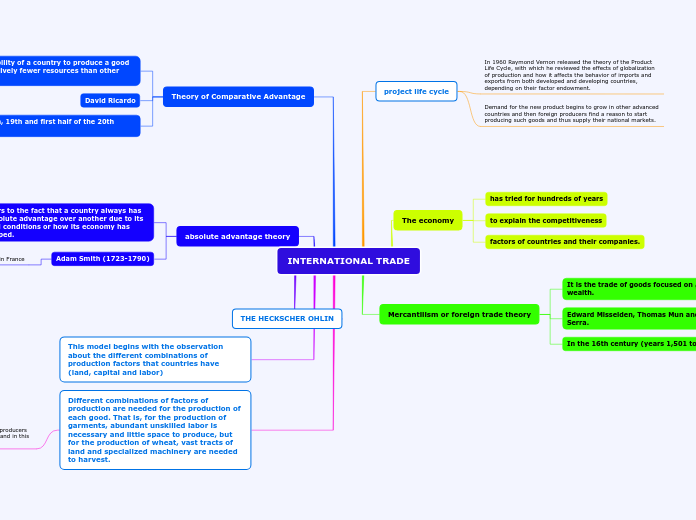INTERNATIONAL TRADE
In linguistics, syntax is the set of rules, principles, and processes that govern the structure of sentences in a given language, usually including word order.
Different combinations of factors of production are needed for the production of each good. That is, for the production of garments, abundant unskilled labor is necessary and little space to produce, but for the production of wheat, vast tracts of land and specialized machinery are needed to harvest.
Demand for the new product begins to
grow in other advanced countries and then foreign producers find a reason to start the production of such goods and in this way. supply their national markets
This model begins with the observation about the different combinations of production factors that countries have (land, capital and labor)
THE HECKSCHER OHLIN
absolute advantage theory
A compound sentence is a sentence that has at least two independent clauses joined by a comma, semicolon or conjunction. An independent clause is a clause that has a subject and verb and forms a complete thought.
Adam Smith (1723-1790)
Create your own compound sentences, using the coordinators above.
In the second half of the 18th century in France
It refers to the fact that a country always has an absolute advantage over another due to its natural conditions or how its economy has developed.
When independent clauses are joined with coordinators (also called coordinating conjunctions), commas and semicolons, they do more than just join the clauses. They add meaning and flow to your writing.
Theory of Comparative Advantage
A complex sentence is a sentence that contains an independent clause and one or more dependent clauses.
An independent clause can stand alone as a sentence, but a dependent clause even though it has a subject and a verb cannot stand alone.
in the 18th, 19th and first half of the 20th century
The subject clause is a dependent clause that acts as a subject.
David Ricardo
A predicative clause may be introduced by conjunctions - that, whether, whether... or, as, as if, as though, because, lest, the way - or connectives.
The latter may be conjunctive pronouns - who, whoever, what, whatever, which - or conjunctive adverbs - where, wherever, when, whenever, how, why.
It is the ability of a country to produce a good using relatively fewer resources than other countries.
The object clause is a phrase on which a verb performs an action. It falls at the end of a sentence, and is governed by a verb or a preposition.
Mercantilism or foreign trade theory
In the 16th century (years 1,501 to 1,600)
See the example below and try to create your own simple sentences.
Tim is the driver.
Edward Misselden, Thomas Mun and Antonio Serra.
See the example below and try to create your own simple sentences.
Tim drives the car.
It is the trade of goods focused on generating wealth.
The economy
factors of countries and their companies.
Traditional grammar defines the object in a sentence as the entity that is acted upon by the subject.
to explain the competitiveness
The predicate of a sentence is the part that modifies the subject in some way. Because the subject is the person, place, or thing that a sentence is about, the predicate must contain a verb explaining what the subject does and can also include a modifier.
has tried for hundreds of years
The subject of a sentence is the person, place, thing, or idea that is doing or being something. You can find the subject of a sentence if you can find the verb.
Ask the question, 'Who or what 'verbs' or 'verbed'?' and the answer to that question is the subject.
project life cycle
Demand for the new product begins to grow in other advanced countries and then foreign producers find a reason to start producing such goods and thus supply their national markets.
In 1960 Raymond Vernon released the theory of the Product Life Cycle, with which he reviewed the effects of globalization of production and how it affects the behavior of imports and exports from both developed and developing countries, depending on their factor endowment.









